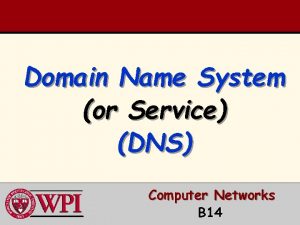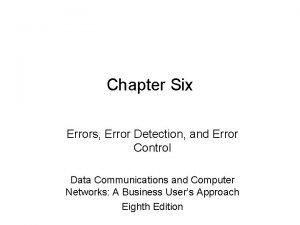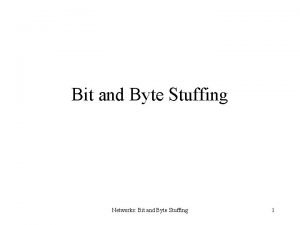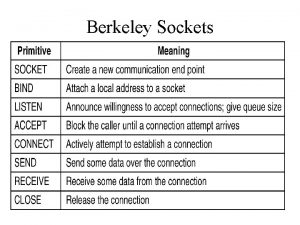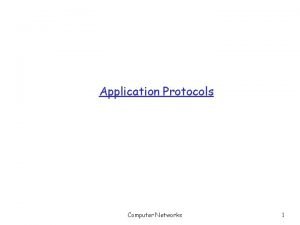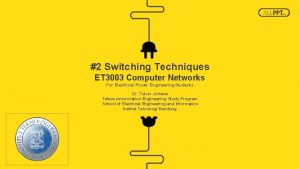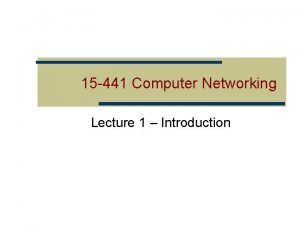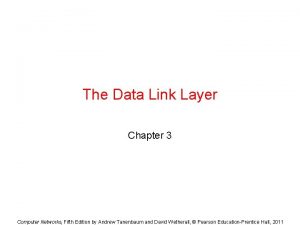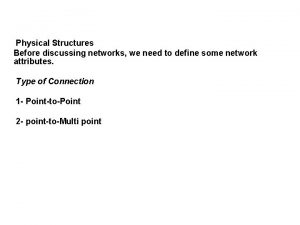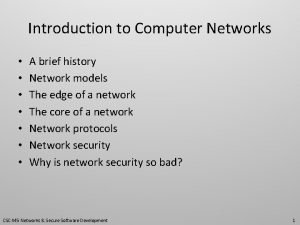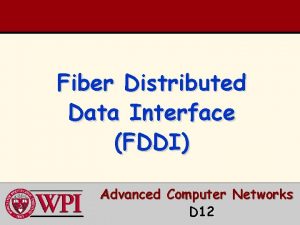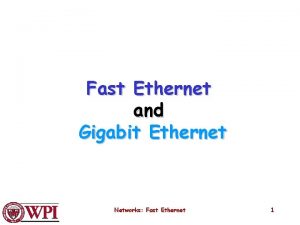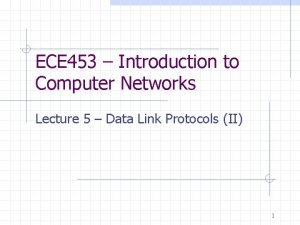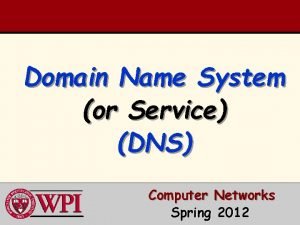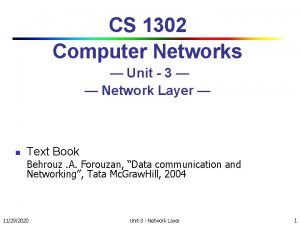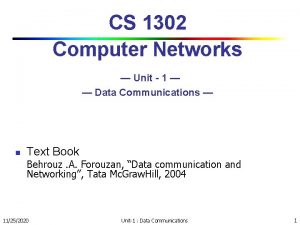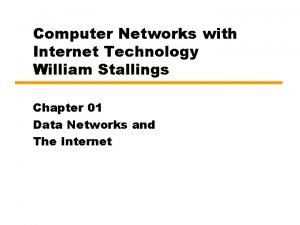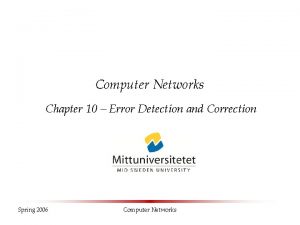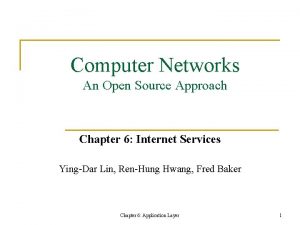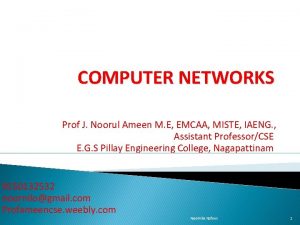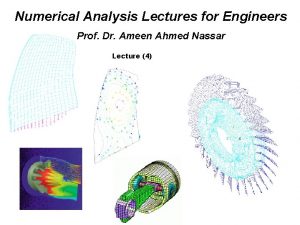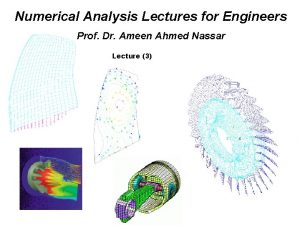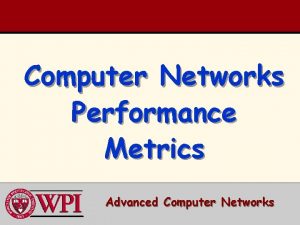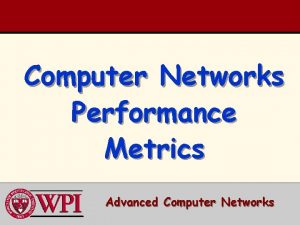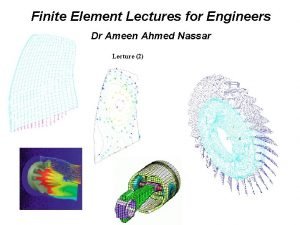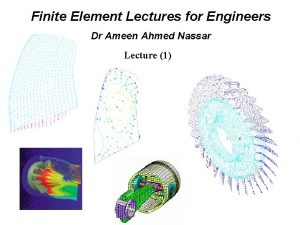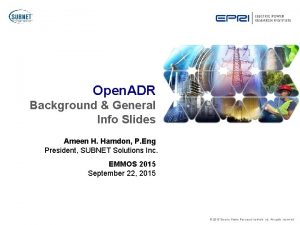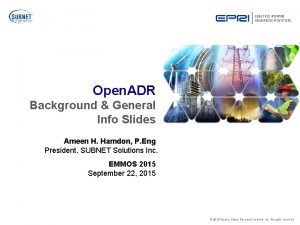COMPUTER NETWORKS Prof J Noorul Ameen M E
























































- Slides: 56

COMPUTER NETWORKS Prof J. Noorul Ameen M. E, EMCAA, MISTE, IAENG. , Assistant Professor/CSE E. G. S Pillay Engineering College, Nagapattinam 9150132532 noornilo@gmail. com Profameencse. weebly. com Noornilo Nafees 1

Course Outcomes �At the end of this course students can able to ◦ CO 1. Explain about computer networks with its types and protocols ◦ CO 2. Explain about various routing protocols ◦ CO 3. Describe the controlling mechanisms available for flow, error and congestion control ◦ CO 4. Demonstrate various concepts in internet protocols, network services and management Noornilo Nafees 2

UNIT 4 -TRANSPORT LAYER � Overview of Transport layer � UDP � Reliable byte stream (TCP) ◦ Connection management ◦ Flow control �Retransmission – � TCP Congestion control � Congestion avoidance (DECbit, RED) � Qo. S ◦ Application requirements Noornilo Nafees 3

Overview of Transport layer � Transport Layer: It provides communication services directly to the application processes running on different host. � It is responsible for process to process communication. � Transport Layer Services: ◦ Connectionless transport service and ◦ Connection oriented transport service � Transport Layer Protocols: � UDP: User Datagram Protocol, used for connectionless transport service. � TCP: Transmission Control Protocol used for connection oriented transport service Noornilo Nafees 4

UDP – USER DATAGRAM PROTOCOL � It is a connectionless transport layer protocol. � There is no handshaking before two processes start to communicate. � It provides unreliable data transfer service. � When a process sends a message into a UDP socket, UDP provides no guarantee that the message will reach the receiving process. � Messages do arrive to the receiving process may arrive out of order. � UDP does not include congestion control mechanism. � So sending process can pump data into a UDP socket at any rate. Noornilo Nafees 5

� Internet telephony is make using of UDP. � Multicasting is supported by UDP. 32 bits Length, in bytes of UDP segment, including header source port # dest port # length checksum Application data (message) UDP segment format Noornilo Nafees 6

TCP-TRANSMISSION CONTROL PROTOCOL � TCP is a connection oriented reliable transport layer protocol. � E-Mail, Web and File transfer all use TCP. Because it provides reliable data transfer service and guarantees that all the data will go its destination. � TCP is said to be connection oriented because, before one application process can begin to send data to another, two processes must first “Handshake” with each other(Connection Establishment). � Before sending data after connection establishment both client and server establishes TCP variables. � TCP Variables: (i) Seq #s � (ii)Buffers, Flowcontrol info(ex: Rcv. Window) Noornilo Nafees 7

� Once a TCP connection is established, the two application processes can send data to each other. � Full Duplex Service: A TCP connection provides full duplex service. � If there is a connection between Process A on one host and Process B on another host, then the data can flow from both sides of Process A and Process B at the same time. � Point to Point Connection: A TCP connection is always point to point. � That is between a single sender and single receiver. � Multicasting is not possible with TCP. Noornilo Nafees 8

� TCP Send & Receive Buffers: � Client Process: Process that initiates connection � Server Process: Process that establishes connection � Data Transfer Steps: TCP Send and Receive Buffers � Each side of connection has its own send and receive buffers. Noornilo Nafees 9

� 1. The client passes a stream of data through the socket. � 2. Once the data passes through the client socket, the data is now in the hands of TCP running in the client. � 3. TCP directs this data to the connections send buffer. � From time to time TCP will grab chunks of data from the send buffer. � 4. The maximum amount of data that can be grabbed and placed in the segment is limited by MAXIMUM SEGMENT SIZE(MSS). � 5. The maximum segment size(MSS) is set by MAXIMUM TRANSMISSION UNIT(MTU). � 6. When TCP receives a segment at the other end, the segments data is placed in the TCP connections receive buffer. � 7. The application reads the stream of data from this buffer. Noornilo Nafees 10

� TCP Segment Structure: Noornilo Nafees 11

� The 32 bit sequence number and acknowledgement number field are used by the TCP for reliable data transfer service. � The 16 bit receive window field is used for flow control. It is used to indicate the no of bytes that a receiver is willing to accept. � The 4 bit header length field specifies the length of the TCP header. � The flag field contains 6 bits. � The ACK bit is used to indicate that the variable carried in the acknowledgement field is valid � That is it contains ack for a segment that has been successfully received. � The RST, SYN and FIN bits are used for connection setup and teardown. Noornilo Nafees 12

� TCP Connection Management: � Establishing TCP Connection(3 way handshaking): Consider a process running in one host(client) wants to initiate a connection with another process in another host(Server). � The client application process first informs the client TCP that it wants to establish a connection to a process in the server. � The TCP in the client then proceeds to establish a TCP connection with the TCP in the server in the following manner: Noornilo Nafees 13

� Step 1: The client side TCP first sends a special TCP segment to the server side TCP, which contains no data. � The SYN bit is set to 1 and it is referred as SYN segment. � The client randomly chooses an initial sequence number client_isn and puts this number in the sequence number field of the initial TCP SYN segment. � Step 2: Once the TCP SYN segment arrives a the server host, the server extracts the TCP SYN segment, allocates the TCP buffers and variables to the connection and sends a connection granted segment to the client TCP. � This segment contains 3 important information such as � (i)SYN bit is set to 1 � (ii)The acknowledgement field of the TCP segment is set to client_isn+1. Noornilo Nafees 14

� The server chooses its own initial sequence number server_isn and puts this value in the sequence number field of TCP segment header. � This connection granted segment is saying that I received your initial sequence number client_isn. I agree to establish this connection. � My own initial sequence number is server_isn. � The connection granted segment is sometime referred as SYNACK segment. � Step 3: Upon receiving the SYNACK segment the client also allocates buffers and variables to the connection. � The client host then sends the last segment that acknowledges the server’s connection granted segment by putting the value server_isn+1 in the Ack field of the TCP segment header. � The SYN bit is set to ‘ 0’, because the connection is established. Noornilo Nafees 15

TCP 3 way handshaking Noornilo Nafees 16

� Connection Tear Down(Closing a Connection): � Step 1: Client sends TCP FIN control segment to server. � Step 2: Server receives FIN, replies with ACK, closes the connection and sends FIN. � Step 3: Client receives FIN & replies with ACK. � Step 4: Server receives ACK & connection is closed. Closing a TCP Connection Noornilo Nafees 17

TCP FLOW CONTROL � The hosts on each side of the TCP Connection sets send and receive buffer. � When the TCP connection receives bytes that are correct and in sequence, it places the data in receive buffer. � The associated application process will read data from this buffer. � Mostly, the receiving application may be busy with some other task. � If the application is relatively slow at reading the data, the sender can very easily overflow the receiver’s receive buffer by sending too much data too quickly. Noornilo Nafees 18

Matching Service: TCP provides a flow control service to eliminate the possibility of the sender overflowing the receiver’s buffer by speed matching service. � Matching the rate at which the sender is sending against the rate at which the receiving application is reading. � Receive Window(rwnd): It is used to give the sender an idea about how much free buffer space is available at the receiver. Receive Buffer � Speed Noornilo Nafees 19

� Example with a context of file transfer: � Consider that host A is sending a large file to host B. � Host B allocates receive buffer to this connection and denotes its size by Rcv. Buffer. � From time to time the application process in Host B reads from the buffer and define the following variables: � Last. Byte. Read: The sequence number of the last byte in the data stream read from the buffer by the application process in Host B. � Last. Byte. Rcvd: The sequence number of last byte in the data stream that has arrived from the network and has been placed in the receive buffer at Host B. � TCP is not permitted to overflow the allocated buffer. � Last. Byte. Rcvd – Last. Byte. Read ≤ Rcv. Buffer Noornilo Nafees 20

� The receive window denoted as Rcv. Window is set to the amount of spare room in the receive buffer. � Rcv. Window = Rcv. Buffer – [Last. Byte. Rcvd – Last. Byte. Read] � TCP in Host B tells TCP in host A about how much spare room it has in the connection buffer by placing its current value of Rcv. Window in the receive window field. � Host A in turn keep track of two variables namely Last. Byte. Sent and Last. Byte. Acked. � The difference between the above two variables is the amount of unacknowledged data, Host A has to be sent to Host B. � By keeping the amount of unacknowledged data less than the value of Rcv. Window, Host A assures that it is not overflowing the receive buffer at host B. � Last. Byte. Sent – Last. Byte. Acked ≤ Rcv. Window Amount of Unacknowledged Data Noornilo Nafees 21

CONGESTION CONTROL � Congestion: It refers to a network state where a node or link carries so much data that it can’t handle and resulting in queuing delay or packet loss and the blocking of new connections. � Congestion occurs when bandwidth is insufficient and network data traffic exceeds capacity. � Approaches to congestion control: � (i)End to End Congestion Control � (ii)Network Assisted Congestion Control Noornilo Nafees 22

� (i)End to End Congestion Control: In this approach, the network layer provides no support to transport layer for congestion control. � The presence of congestion in the network must be inferred by the end systems, based only on observed network behavior like packet loss and delay. � TCP must necessarily take this end to end approach towards congestion control, since network layer provides no feedback to the end systems regarding network congestion. � TCP segment loss is taken as indication of network congestion. Noornilo Nafees 23

� (ii)Network Assisted Congestion Control: In this approach the network layer components such as routers provide explicit feedback from the network to sender in two ways as follows: � WAY 1: Direct feedback is sent from a network router to the sender. � This form of notification typically takes the form of a choke packet saying that “I am Congested”. � WAY 2: This form of notification occurs when a router marks a field in a packet flowing from sender to receiver to indicate congestion. � Upon receipt of a marked packet, the receiver then notifies the sender about congestion Noornilo Nafees 24

Two feedback pathways for network indicated congestion information Noornilo Nafees 25

TCP CONGESTION CONTROL � TCP provides a reliable transport service between two processes running on different hosts. � TCP uses end to end congestion control approach. � Approaches: � (i)Limiting each sender, the rate at which it sends traffic into its connection as a function of perceived network congestion. � (ii)If TCP sender perceives, that there is a little congestion on the path, between itself and its destination, then the sender increases its sending rate. � (iii)If the sender perceives that there is congestion along the path, then the sender reduces its sending rate. Noornilo Nafees 26

� The above approaches raises 3 questions: � (i)How does a TCP sender limit the rate at which it sends traffic into its connection? � (ii)How does a TCP sender perceive that there is a congestion on the path between itself and its destination? � (iii)What algorithm should sender use to change its sending rate as a function of perceived end to end congestion control? Noornilo Nafees 27

� (i)How does a TCP sender limit the rate at which it sends traffic into its connection? � Each side of a TCP connection consist of send buffer, receive buffer & variables like Last. Byte. Read, Rcv. Window. . � The TCP Congestion control mechanism has each side of connection, keep track of a variable called congestion window congwin. � It imposes a condition on the rate at which a TCP sender can send traffic into network. � The amount of unacknowledged data at a sender may not exceed the minimum of congwin. � The above constraints limits the amount of unacknowledged data at the sender and indirectly limits the senders sending rate. � By adjusting the value of congwin, the sender can adjust the rate at which it sends data into its connection. Noornilo Nafees 28

� (ii)How does a TCP sender perceive that there is a congestion on the path between itself and its destination? � Let us define a loss event at a TCP sender as the occurrence of either time out/receipt of duplicate acks(NAKs) from the receiver. � When there is a excessive congestion, the one or more router’s buffer along the path overflows, causing a datagram containing TCP segment to be dropped. � The dropped datagram, in turn results in a loss event at the sender, either a timeout or three duplicate acks, which is taken by the sender as an indication of congestion on path. � TCP uses acknowledgments to trigger its increase in congestion window size & it is said to be self clocking. Noornilo Nafees 29

� (iii)What algorithm should sender use to change its sending rate as a function of perceived end to end congestion control? � The TCP sender uses Celebrated TCP Congestion Control Algorithm to change its sending rate as a function of end to end congestion control. � Celebrated TCP Congestion Control Algorithm: This algorithm has 3 major components. � (a)Additive increase and multiplicative decrease(AIMD) � (b)Slow start � (c)Reaction to time out events Noornilo Nafees 30

� (a)Additive increase and multiplicative decrease(AIMD): � The basic idea behind the TCP Congestion control is for the sender to reduce its sending rate by decreasing its congestion window size. � A TCP sender additively increases its sending rate, when it perceives that the end to end path is congestion free. � A TCP sender multiplicatively decreases its sending rate when it detects that the path is congested by loss event. � The TCP sender halves the current value of congestion window after a loss event. � If the value of TCP sender’s congwin is currently 20 kb and if a loss is detected congwin is cut into half to 10 kb. � If another loss event occurs, congwin is further reduced to 5 kb. Noornilo Nafees 31

� The value of congwin may continue to drop, but it is not allowed to drop below 1 mss. � This linear increase phase of TCP congestion control mechanism is known as congestion avoidance. � The value of congwin repeatedly goes through cycles during which it increases linearly & then suddenly drop to half of its current value, giving rise to a saw-toothed pattern in long lived TCP connections. Noornilo Nafees 32

AIMD Congestion Control Noornilo Nafees 33

Start: When a TCP connection begins, the value of congwin is typically initialized to 1 MSS/RTT. � Instead of increasing its rate linearly during this initial phase, a TCP sender increases it rate exponentially, until there is a loss event. � If there is a loss event the congwin is cut into half & then grows linearly as in AIMD. Window � (b)Slow Loss t Exponential “slow start” Noornilo Nafees 34

� (c)Reaction to time out events: � When a TCP connection begins, it enters into slow start phase. � If a loss event occurs AIMD saw-toothed pattern begins. Noornilo Nafees 35

CONGESTION AVOIDANCE � Router-based Congestion Avoidance: ◦ DECbit: �Routers explicitly notify sources about congestion. � Each packet has a “Congestion Notification” bit called the DECbit in its header. � If any router on the path is congested, it sets the DECbit. � To notify the source, the destination copies DECbit into ACK packets. � Source adjusts rate to avoid congestion. ◦ Counts fraction of DECbits set in each window. ◦ If <50% set, increase rate additively. ◦ If >=50% set, decrease rate multiplicatively. Noornilo Nafees 36

� Random Early Detection (RED): � Routers implicitly notify sources by dropping packets. � RED drops packets at random, and as a function of the level of congestion. � RED is based on DECbit, and was designed to work well with TCP. � RED implicitly notifies sender by dropping packets. � Drop probability is increased as the average queue length increases. Noornilo Nafees 37

idea of RED: ◦ Router notices that the queue is getting backlogged. ◦ Randomly drops packets to signal congestion � Packet drop probability: ◦ Drop probability increases as queue length increases ◦ If buffer is below some level, don’t drop anything ◦ Otherwise, set drop probability as function of queue Probability � Basic Average Queue Length Noornilo Nafees 38

� Properties of RED: � Drops packets before queue is full ◦ In the hope of reducing the rates of some flows � Drops packet in proportion to each flow’s rate ◦ High-rate flows have more packets ◦ Hence, a higher chance of being selected � Drops are spaced out in time ◦ Which should help desynchronize the TCP senders � Tolerant of burstiness in the traffic ◦ By biasing the decisions on average queue length Noornilo Nafees 39

Qo. S-QUALITY OF SERVICE � It refers to the capability of a network to provide better service to network traffic. � Flow Characteristics: � Traditionally, four types of characteristics are attributed to a flow: � 1. Reliability, � 2. Delay, � 3. Jitter and � 4. Bandwidth Noornilo Nafees 40

� 1. Reliability: Reliability is a characteristic that a flow needs. Lack of reliability means losing a packet or acknowledgment, which entails retransmission. � The sensitivity of application programs to reliability is not the same. � For example, it is more important that electronic mail, file transfer, and Internet access have reliable transmissions than telephony or audio conferencing. � Delay: � Source-to-destination delay is another flow characteristic. � Applications can tolerate delay in different degrees. In this case, telephony, audio conferencing and video conferencing need minimum delay, while delay in file transfer or e-mail is less important. Noornilo Nafees 41

� 3. Jitter: Jitter is the variation in delay for packets belonging to the same flow. � High jitter means the difference � between delays is large; low jitter means the variation is small. � For example, if four packets depart at times 0, 1, 2, 3 and arrive at 20, 21, 22, 23, all have the same delay, 20 units of time. � On the other hand, if the above four packets arrive at 21, 23, 21, and 28, they will have different delays: 21, 22, 19, and 24. � For applications such as audio and video, the first case is completely acceptable, the second case is not. Noornilo Nafees 42

� 4. Bandwidth: � Different applications need different bandwidths. � In video conferencing we need to send millions of bits per second to refresh a color screen while the total number of bits in an e-mail may not reach even a million. TECHNIQUES TO IMPROVE Qo. S: � 1. Scheduling � 2. Traffic Shaping � 3. Resource Reservation � 4. Admission Control Noornilo Nafees 43

� 1. Scheduling: Packets from different flows arrive at a router for processing. � A good scheduling technique treats the different flows in a fair and appropriate manner. � Several scheduling techniques are designed to improve the quality of service. � We discuss three of them here: � (i)FIFO queuing � (ii)Priority queuing and � (iii)weighted fair queuing. Noornilo Nafees 44

� (i)FIFO Queuing: � In first-in, first-out (FIFO) queuing, packets wait in a buffer (queue) until the router is ready to process them. � If the average arrival rate is higher than the average processing rate, the queue will fill up and new packets will be discarded. FIFO queue Noornilo Nafees 45

� (ii)Priority Queuing: � In priority queuing, packets are first assigned to a priority class. � Each priority class has its own queue. � The packets in the highest-priority queue are processed first. � Packets in the lowest-priority queue are processed last. � A priority queue can provide better Qo. S than the FIFO queue because higher priority traffic, such as multimedia, can reach the destination with less delay. Noornilo Nafees 46

� However, there is a potential drawback. If there is a continuous flow in a high-priority queue, the packets in the lower-priority queues will never have a chance to be processed. � This is a condition called starvation. Priority queuing Noornilo Nafees 47

� (iii)Weighted Fair Queuing: A better scheduling method is weighted fair queuing. � In this technique, the packets are still assigned to different classes and admitted to different queues. � The queues are weighted based on the priority of the queues � Higher priority means a higher weight. � The system processes packets in each queue in a roundrobin fashion with the number of packets selected from each queue based on the corresponding weight. Noornilo Nafees 48

� For example, if the weights are 3, 2, and 1, three packets are processed from the first queue, two from the second queue, and one from the third queue. Weighted fair queuing Noornilo Nafees 49

� 2. Traffic Shaping: Traffic shaping is a mechanism to control the amount and the rate of the traffic sent to the network. � Two techniques can shape traffic: � (i)Leaky bucket algorithm and � (ii)Token bucket algorithm. � (i)Leaky Bucket Algorithm: If a bucket has a small hole at the bottom, the water leaks from the bucket at a constant rate as long as there is water in the bucket. � The rate at which the water leaks does not depend on the rate at which the water is input to the bucket unless the bucket is empty. � The input rate can vary, but the output rate remains constant. Noornilo Nafees 50

in networking, a technique called leaky bucket can smooth out bursty traffic. � Bursty chunks are stored in the bucket and sent out at an average rate. Leaky Bucket Algorithm � Similarly, Noornilo Nafees 51

� In this simple leaky bucket implementation is a FIFO queue holds the packets. � If the traffic consists of fixed-size packets the process removes a fixed number of packets from the queue at each tick of the clock. � If the traffic consists of variable-length packets, the fixed output rate must be based on the number of bytes or bits. � If the rule is 1024 bytes per tick, a single 1024 byte packet can be admitted on a tick, two 512 byte packets and so on. Noornilo Nafees 52

� The following is an algorithm for variable-length packets: � 1. Initialize a counter to n at the tick of the clock. � 2. If n is greater than the size of the packet, send the packet and decrement the counter by the packet size. � Repeat this step until n is smaller than the packet size. � 3. Reset the counter and go to step 1. � (ii)Token bucket algorithm: The token bucket allows bursty traffic at a regulated maximum rate. � The token bucket algorithm allows idle hosts to accumulate credit for the future in the form of tokens. � For each tick of the clock, the system sends n tokens to the bucket. � The system removes one token for every cell (or bytes) of data sent. Noornilo Nafees 53

example, if n is 100 and the host is idle for 100 ticks, the bucket collects 10, 000 tokens. � Now the host can consume all these tokens in one tick with 10, 000 cells, or the host takes 1000 ticks with 10 cells per tick. � In other words, the host can send bursty data as long as the bucket is not empty. Token Bucket Algorithm � For Noornilo Nafees 54

� 3. Resource Reservation: � A flow of data needs resources such as a buffer, bandwidth, CPU time, and so on. � The quality of service is improved if these resources are reserved beforehand. � 4. Admission Control: � Admission control refers to the mechanism used by a router, or a switch, to accept or reject a flow based on predefined parameters called flow specifications. � Before a router accepts a flow for processing, it checks the flow specifications to see if its capacity (in terms of bandwidth, buffer size, CPU speed, etc. ) and its previous commitments to other flows can handle the new flow. Noornilo Nafees 55

� Flow Specification: When a source makes a reservation, it needs to define a flow specification. � A flow specification has two parts: Rspec (resource specification) and Tspec (traffic specification). � Rspec defines the resource that the flow needs to reserve (buffer, bandwidth, etc. ). � Tspec defines the traffic characterization of the flow. � Admission: After a router receives the flow specification from an application, it decides to admit or deny the service. The decision is based on the previous commitments of the router and the current availability of the resource. Noornilo Nafees 56
 Rihani dune
Rihani dune Amen meaning
Amen meaning Datagram network and virtual circuit network
Datagram network and virtual circuit network Backbone networks in computer networks
Backbone networks in computer networks Crc in computer networks
Crc in computer networks Crc in computer networks
Crc in computer networks Traffic management in computer networks
Traffic management in computer networks Tpdu in computer networks
Tpdu in computer networks What is optimality principle in computer networks
What is optimality principle in computer networks Snmp ports
Snmp ports What is optimality principle in computer networks
What is optimality principle in computer networks Business applications in computer networks
Business applications in computer networks Classify computer networks based on transmission technology
Classify computer networks based on transmission technology Intro dns
Intro dns Intserv vs diffserv
Intserv vs diffserv Icmp in computer networks
Icmp in computer networks Http computer networks
Http computer networks Character stuffing in computer networks
Character stuffing in computer networks Dns in computer networks
Dns in computer networks Computer network assignment
Computer network assignment Distributed system in computer network
Distributed system in computer network Computer networks routing algorithms
Computer networks routing algorithms Error correction techniques in computer networks
Error correction techniques in computer networks Checksum in computer networks with example
Checksum in computer networks with example Internet transport protocol in computer networks
Internet transport protocol in computer networks Error control in computer networks
Error control in computer networks Subnet
Subnet Switching in data link layer
Switching in data link layer Layered task in network model
Layered task in network model Byte stuffing
Byte stuffing Bit stuffing and byte stuffing in computer networks
Bit stuffing and byte stuffing in computer networks What is bit and byte stuffing? explain with example
What is bit and byte stuffing? explain with example Socket primitives
Socket primitives Arp vs rarp
Arp vs rarp Ftp protocol in computer networks
Ftp protocol in computer networks Principles of network applications
Principles of network applications Https://speakerdeck.com/
Https://speakerdeck.com/ Cmu 15-441
Cmu 15-441 Utopian simplex protocol
Utopian simplex protocol Sonet in computer networks
Sonet in computer networks Cell switching in computer networks
Cell switching in computer networks Physical structures in computer networks
Physical structures in computer networks Presentation layer in computer networks
Presentation layer in computer networks The network layer is concerned with
The network layer is concerned with Brief history of computer network
Brief history of computer network What is fddi in computer network
What is fddi in computer network Fast ethernet network
Fast ethernet network Ethernet frame format
Ethernet frame format Unrestricted simplex protocol in computer networks
Unrestricted simplex protocol in computer networks Dns in computer networks
Dns in computer networks Analogue and digital transmission in computer networks
Analogue and digital transmission in computer networks Cs 1302
Cs 1302 Data communication components
Data communication components Principles of congestion control in computer networks
Principles of congestion control in computer networks William stallings computer networks
William stallings computer networks Crc in computer networks
Crc in computer networks Computer networks an open source approach
Computer networks an open source approach


















